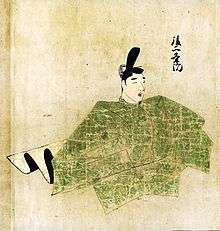Emperor Go-Nijō
| Go-Nijō | |
|---|---|
| Emperor of Japan | |
 Go-Nijō | |
| Reign | 1301–1308 |
| Predecessor | Go-Fushimi |
| Successor | Hanazono |
| Born | March 9, 1285 |
| Died | September 10, 1308 (aged 23) |
| Burial | Kitashirakawa no Misasagi (Kyoto) |
| Spouse | Fujiwara no Kinshi |
Emperor Go-Nijō (後二条天皇 Go-Nijō-tennō) (March 9, 1285 – September 10, 1308) was the 94th emperor of Japan, according to the traditional order of succession. He reigned from March 3, 1301 until September 10, 1308.[1]
This 14th-century sovereign was named after the 12th-century Emperor Nijō, and go- (後), translates literally as "later;" and thus, he is sometimes called the "Later Emperor Nijō," or, in some older sources, may be identified as "Nijō, the second" or as "Nijo II."
Genealogy
Before his ascension to the Chrysanthemum Throne, his personal name (his imina) was Kuniharu-shinnō (邦治親王).[2]
Go-Nijō was the eldest son of the 91st Emperor Emperor Go-Uda. He belonged to the Daikakuji-tō branch of the Imperial Family.
Events of Go-Nijō's life
Kuniharu-shinnō was made an imperial prince by Imperial proclamation in 1286.
In 1296, he became crown prince (heir) to the Jimyōin-tō Emperor Go-Fushimi, his second cousin.
- Shōan 3, in the 1st month (1301): In the 5th year of Go-Fushimi-tennō's reign (後伏見天皇五年), the emperor was forced to abdicate; and the succession (‘‘senso’’) was received by his cousin. Shortly thereafter, Emperor Go-Nijō is said to have acceded to the throne (‘‘sokui’’).[3]
Go-Nijō's father, the Emperor Go-Uda reigned as cloistered emperor during his reign.
The succession dispute between the Daikakuji and Jimyōin branches of the Imperial Family continued during his reign. His grandfather, the retired Emperor Emperor Kameyama was said to have acted through the Bakufu to ensure Go-Nijō's enthronement.

On September 10, 1308, Go-Nijō died of illness.
Go-Nijō is buried at Kitashirakawa no misasagi (北白河陵) in Sakyō-ku, Kyoto.[4]
Kugyō
Kugyō (公卿) is a collective term for the very few most powerful men attached to the court of the Emperor of Japan in pre-Meiji eras. Even during those years in which the court's actual influence outside the palace walls was minimal, the hierarchic organization persisted.
In general, this elite group included only three to four men at a time. These were hereditary courtiers whose experience and background would have brought them to the pinnacle of a life's career. During Nijō's reign, this apex of the Daijō-kan included:
- Kampaku, Nijō Kanemoto, 1300–1305
- Kampaku, Kujō Moronori, 1305–1308
- Sadaijin
- Udaijin
- Nadaijin
- Dainagon
Eras of Go-Nijō's reign
The years of Go-Nijō's reign are more specifically identified by more than one era name or nengō.[5]
Notes

- ↑ Titsingh, Isaac. (1834). Annales des empereurs du Japon, pp. 275–278; Varley, H. Paul. (1980). Jinnō Shōtōki. p. 239.
- ↑ Titsingh, p. 275; Varley, p. 239.
- ↑ Titsingh, p. 275; Varley, p. 44; n.b., a distinct act of senso is unrecognized prior to Emperor Tenji; and all sovereigns except Jitō, Yōzei, Go-Toba, and Fushimi have senso and sokui in the same year until the reign of Emperor Go-Murakami.
- ↑ Ponsonby-Fane, Richard. (1959). The Imperial House of Japan, p. 422.
- ↑ Titsingh, p. 275.
References
- Ponsonby-Fane, Richard Arthur Brabazon. (1959). The Imperial House of Japan. Kyoto: Ponsonby Memorial Society. OCLC 194887
- Titsingh, Isaac. (1834). Nihon Odai Ichiran; ou, Annales des empereurs du Japon. Paris: Royal Asiatic Society, Oriental Translation Fund of Great Britain and Ireland. OCLC 5850691
- Varley, H. Paul. (1980). Jinnō Shōtōki: A Chronicle of Gods and Sovereigns. New York: Columbia University Press. ISBN 978-0-231-04940-5; OCLC 59145842
See also
| Regnal titles | ||
|---|---|---|
| Preceded by Emperor Go-Fushimi |
Emperor of Japan: Go-Nijō 1301–1308 |
Succeeded by Emperor Hanazono |
